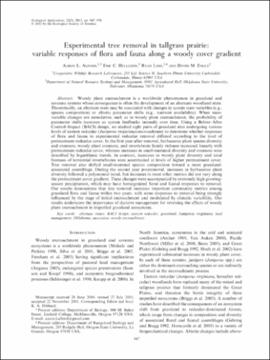| dc.contributor.author | Alford, Aaron L. | |
| dc.contributor.author | Hellgren, Eric C. | |
| dc.contributor.author | Limb, Ryan Frank | |
| dc.contributor.author | Engle, David M. | |
| dc.date.accessioned | 2019-08-22T17:50:53Z | |
| dc.date.available | 2019-08-22T17:50:53Z | |
| dc.date.issued | 2012 | |
| dc.identifier | oksd_alford_experimentaltre_2012 | |
| dc.identifier.citation | Alford, A. L., Hellgren, E. C., Limb, R., & Engle, D. M. (2012). Experimental tree removal in tallgrass prairie: Variable responses of flora and fauna along a woody cover gradient. Ecological Applications, 22(3), 947-958. https://doi.org/10.1890/10-1288.1 | |
| dc.identifier.uri | https://hdl.handle.net/11244/321243 | |
| dc.description.abstract | Woody plant encroachment is a worldwide phenomenon in grassland and savanna systems whose consequence is often the development of an alternate woodland state. Theoretically, an alternate state may be associated with changes in system state variables (e.g., species composition) or abiotic parameter shifts (e.g., nutrient availability). When state-variable changes are cumulative, such as in woody plant encroachment, the probability of parameter shifts increases as system feedbacks intensify over time. Using a Before-After Control-Impact (BACI) design, we studied eight pairs of grassland sites undergoing various levels of eastern redcedar (Juniperus virginiana) encroachment to determine whether responses of flora and fauna to experimental redcedar removal differed according to the level of pretreatment redcedar cover. In the first year after removal, herbaceous plant species diversity and evenness, woody plant evenness, and invertebrate family richness increased linearly with pretreatment redcedar cover, whereas increases in small-mammal diversity and evenness were described by logarithmic trends. In contrast, increases in woody plant diversity and total biomass of terrestrial invertebrates were accentuated at levels of higher pretreatment cover. Tree removal also shifted small-mammal species composition toward a more grassland-associated assemblage. During the second year postremoval, increases in herbaceous plant diversity followed a polynomial trend, but increases in most other metrics did not vary along the pretreatment cover gradient. These changes were accompanied by extremely high growing-season precipitation, which may have homogenized floral and faunal responses to removal. Our results demonstrate that tree removal increases important community metrics among grassland flora and fauna within two years, with some responses to removal being strongly influenced by the stage of initial encroachment and modulated by climatic variability. Our results underscore the importance of decisive management for reversing the effects of woody plant encroachment in imperiled grassland ecosystems. | |
| dc.format | application/pdf | |
| dc.language | en_US | |
| dc.publisher | Ecological Society of America | |
| dc.rights | This material has been previously published. In the Oklahoma State University Library's institutional repository this version is made available through the open access principles and the terms of agreement/consent between the author(s) and the publisher. The permission policy on the use, reproduction or distribution of the material falls under fair use for educational, scholarship, and research purposes. Contact Digital Resources and Discovery Services at lib-dls@okstate.edu or 405-744-9161 for further information. | |
| dc.title | Experimental tree removal in tallgrass prairie: Variable responses of flora and fauna along a woody cover gradient | |
| osu.filename | oksd_alford_experimentaltre_2012.pdf | |
| dc.description.peerreview | Peer reviewed | |
| dc.identifier.doi | 10.1890/10-1288.1 | |
| dc.description.department | Natural Resource Ecology and Management | |
| dc.type.genre | Article | |
| dc.type.material | Text | |
| dc.subject.keywords | alternate states | |
| dc.subject.keywords | baci design | |
| dc.subject.keywords | eastern redcedar | |
| dc.subject.keywords | grassland | |
| dc.subject.keywords | juniperus virginiana | |
| dc.subject.keywords | land management | |
| dc.subject.keywords | oklahoma | |
| dc.subject.keywords | succession | |
| dc.subject.keywords | woody encroachment | |
